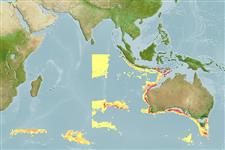Élasmobranches (requins et raies) (sharks and rays) >
Carcharhiniformes (Ground sharks) >
Scyliorhinidae (Cat sharks) > Scyliorhininae
Etymology: Cephaloscyllium: cephalus, from kephale (Gr.), head, referring to its very broad and depressed head; skylion, Greek for dogfish or small shark. (See ETYFish); hiscosellum: hisco (L.), open; sella (L.), saddle, referring to distinctive open-centered saddle-like markings that dominate its color pattern. (See ETYFish).
Environment: milieu / climate zone / depth range / distribution range
Écologie
marin bathypélagique; profondeur 294 - 420 m (Ref. 76949). Subtropical
Eastern Indian Ocean: Australia.
Length at first maturity / Taille / Poids / Âge
Maturity: Lm 46.0, range 46 - 46.3 cm
Max length : 46.3 cm TL mâle / non sexé; (Ref. 76949); 52.0 cm TL (female)
Description synthétique
Clés d'identification | Morphologie | Morphométrie
A small species with the following characters: head 8.9-13.1% TL in height, trunk width 12.9-19.1% TL; origin of first dorsal-fin usually over mid pelvic-fin base; prenarial length 4.5-5.2% TL; preorbital snout length 1.4-1.6 times prenarial length, 2.6-3.1 in prepectoral length, 5.9-6.7 in prepelvic length; snout-vent length long, 46.2-51.2% TL; nostril 2.5-3.1% TL in width; eye-spiracle space wide, 0.8-1.2% TL; pectoral fin moderate-sized, height 8.7-12.2% TL, posterior margin length 7.4-11.4% TL; anal fin relatively low, height 2.8-3.7% TL; anal-caudal space 5.4-6.5% TL; precaudal length 76.4-79.2% TL; interdorsal space 7.4-9.6% TL; teeth with 3-5 cusps near symphysis of upper jaw; flank denticles are mainly unicuspidate; back without greatly enlarged denticles; long adult clasper, up to 9.3% TL, reaching anal-fin origin; vertebral centra 100-108; low tooth count, each jaw with teeth between 45 and 63; dorsal surface with a striking pattern of dark brown, open-centered saddles (Ref. 76949).
Life cycle and mating behavior
Maturities | Reproduction | Spawnings | Egg(s) | Fecundities | Larves
White, W.T. and D.A. Ebert, 2008. Cephaloscyllium hiscosellum sp. nov., a new swell shark (Carcharhiniformes: Scyliorhinidae) from Northwestern Australia. pp. 147-157. In P.R. Last, W.T. White and J.J. Pogonoski (eds). Descriptions of new Australian chondrichthyans. CSIRO Marine and Atmospheric Research Paper no. 22. 365 p. (Ref. 76949)
Statut dans la liste rouge de l'IUCN (Ref. 130435)
Menace pour l'homme
Harmless
Utilisations par l'homme
Outils
Articles particuliers
Télécharger en XML
Sources Internet
Estimates based on models
Preferred temperature (Ref.
123201): 7.7 - 12.5, mean 11.8 °C (based on 14 cells).
Phylogenetic diversity index (Ref.
82804): PD
50 = 0.5000 [Uniqueness, from 0.5 = low to 2.0 = high].
Bayesian length-weight: a=0.00263 (0.00139 - 0.00497), b=3.21 (3.04 - 3.38), in cm total length, based on LWR estimates for this (Sub)family-body shape (Ref.
93245).
Niveau trophique (Ref.
69278): 4.0 ±0.5 se; based on size and trophs of closest relatives
Résilience (Ref.
120179): Faible, temps minimum de doublement de population : 4,5 à 14 années (Preliminary low fecundity).
Fishing Vulnerability (Ref.
59153): Moderate vulnerability (41 of 100).
